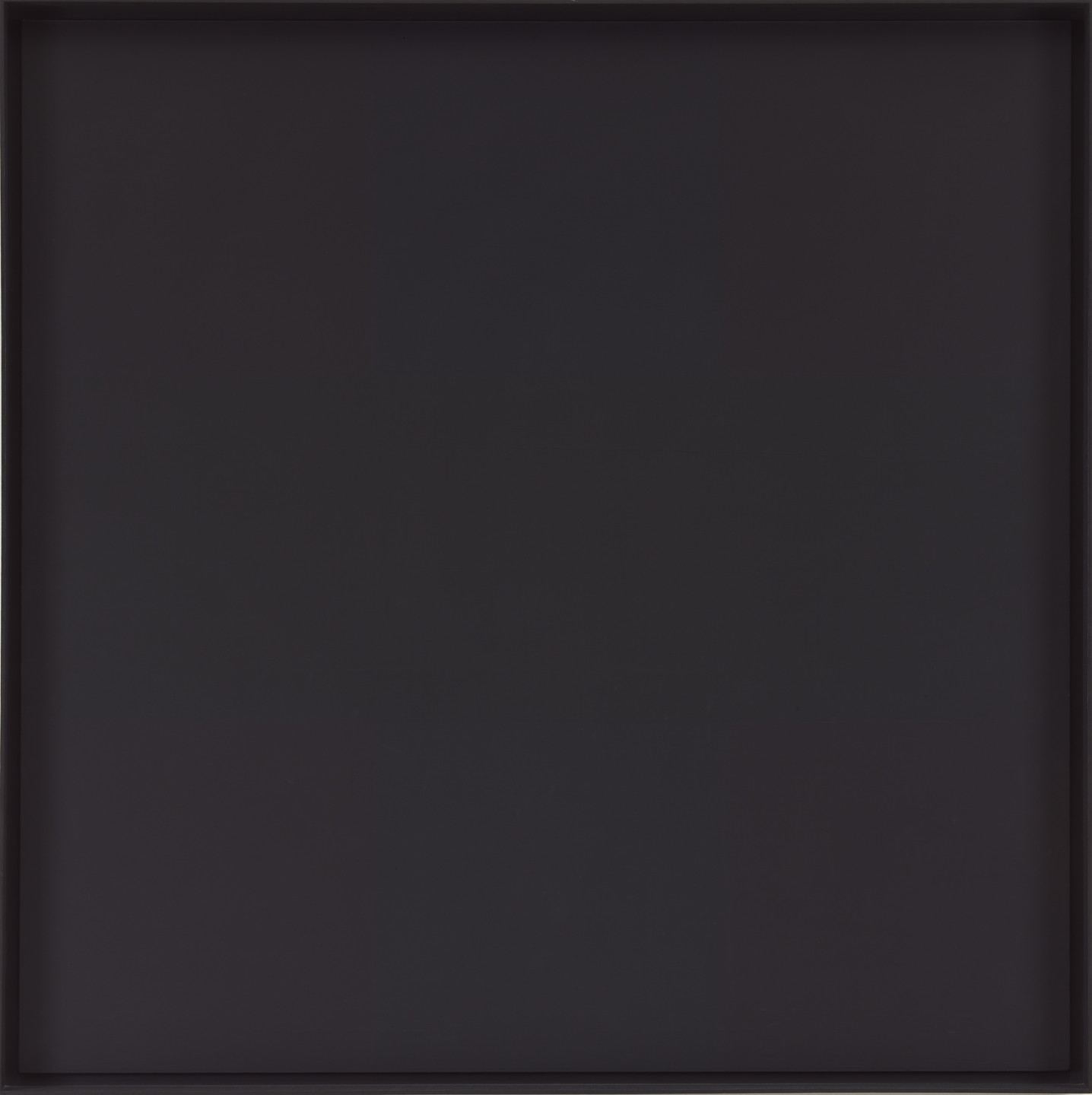Black Guy With Sprem Around Him Modern Art Painting

Ad Reinhardt Abstract Painting 1963
At outset glance this painting presents a flat blackness surface. Only longer viewing reveals more than ane shade of black and an underlying geometric structure. Reinhardt has divided the canvas into a 3-by-iii grid of squares. The black in each corner foursquare has a cherry-red tone; the shape between them formed by the center squares is blueish-blackness in its vertical bar and greenish-black in its horizontal bar. Reinhardt tried to produce what he described equally "a pure, abstract, not-objective, timeless, spaceless, changeless, relationless, disinterested painting—an object that is cocky-witting (no unconsciousness), ideal, transcendent, enlightened of no thing just art."
Gallery characterization from 2007.
Abstruse Painting contains three distinct shades of black, which become visible just later prolonged looking. Reinhardt was intensely sensitive to such subtle variations. He explained, "There is a black which is old and a blackness which is fresh. Lustrous black and dull black, black in sunlight and black in shadow." When Reinhardt'southward black paintings were first exhibited at MoMA, in 1963, their reductive imagery and stark palette shocked visitors, prompting at least i Museum membership cancellation in protestation.
Gallery characterization from Abstract Expressionist New York, October 3, 2010-April 25, 2011.
In the last ten years of his life, Reinhardt focused solely on square, blackness paintings. In his unpublished writings, the creative person indicates that these pictures relate aesthetically to monotonal Chinese paintings rather than Western painting's concepts of light and dark. These canvases are intentionally enigmatic, painted to resist estimation and to stand for the beginning of a new way of seeing and thinking nigh art. In 1961, Reinhardt described them thus:
A square (neutral, shapeless) sheet, 5 feet wide, v anxiety high, as high as a man, every bit broad as a man'south outstretched artillery (non big, not minor, sizeless), trisected (no composition), one horizontal form negating one vertical class (formless, no top, no bottom, directionless), three (more or less) dark (lightless) no–contrasting (colorless) colors, brushwork brushed out to remove brushwork, a matte, flat, free–hand, painted surface (glossless, textureless, non–linear, no hard-edge, no soft border) which does non reflect its surroundings—a pure, abstruse, non–objective, timeless, spaceless, changeless, relationless, disinterested painting—an object that is self–conscious (no unconsciousness) ideal, transcendent, aware of no thing but fine art (absolutely no anti–fine art).
Gallery label from Focus: Advertizing Reinhardt and Mark Rothko, 2008.
To the hasty viewer, Abstract Painting must present a apartment blackness. Simply the piece of work holds more than than 1 shade of black, and longer viewing reveals an abstract geometrical image. Reinhardt has divided the canvas into a three-by-3 filigree of squares. The black in each corner square has a ruby tone; the shape between them—a cantankerous, filling the eye square of the canvas and the foursquare in the centre of each side—is a blue black in its vertical bar and a greenish black in its horizontal i.
Works like this were strongly influential for the Minimalist and Conceptual artists of the 1960s, who admired their reductive and systematic rigor. But the verse of their finely handled surfaces, and their deeply contemplative graphic symbol, necktie them to the Abstruse Expressionist generation of which Reinhardt was a fellow member, if a dissident ane. Insisting on the separation of fine art from life, Reinhardt tried to erase from his work whatsoever content other than fine art itself. In the late blackness canvases that include Abstruse Painting (he chosen them his "ultimate" paintings) he was trying to produce what he described as "a pure, abstract, non-objective, timeless, spaceless, changeless, relationless, disinterested painting—an object that is self-conscious (no unconsciousness), ideal, transcendent, aware of no matter but art."
Publication excerpt from The Museum of Mod Fine art, MoMA Highlights, New York: The Museum of Mod Art, revised 2004, originally published 1999, p. 243.
- Medium
- Oil on sheet
- Dimensions
- threescore x 60" (152.4 x 152.4 cm)
- Credit
- Gift of Mrs. Morton J. Hornick
- Object number
- 143.1977
- Copyright
- © 2022 Estate of Ad Reinhardt / Artists Rights Gild (ARS), New York
- Section
- Painting and Sculpture
We take identified these works in the post-obit photos from our exhibition history.
In 2018–19, MoMA collaborated with Google Arts & Civilization Lab on a project using machine learning to identify artworks in installation photos. That project has concluded, and works are now being identified by MoMA staff.
If you notice an error, please contact us at [email protected].
If y'all would like to reproduce an image of a work of art in MoMA's collection, or an image of a MoMA publication or archival textile (including installation views, checklists, and press releases), please contact Art Resource (publication in Northward America) or Scala Archives (publication in all other geographic locations).
MoMA licenses archival audio and select out of copyright film clips from our film collection. At this time, MoMA produced video cannot be licensed by MoMA/Scala. All requests to license archival sound or out of copyright pic clips should be addressed to Scala Archives at [email protected]. Movement picture pic stills cannot be licensed by MoMA/Scala. For admission to motion picture film stills for research purposes, please contact the Film Study Center at [email protected]. For more information about picture show loans and our Circulating Moving picture and Video Library, delight visit https://www.moma.org/enquiry-and-learning/circulating-flick.
If you would like to reproduce text from a MoMA publication, please email [e-mail protected]. If you would like to publish text from MoMA's archival materials, delight fill out this permission grade and send to [email protected].
This record is a work in progress. If you take additional data or spotted an fault, please ship feedback to [electronic mail protected].
Source: https://www.moma.org/collection/works/78976
0 Response to "Black Guy With Sprem Around Him Modern Art Painting"
Post a Comment